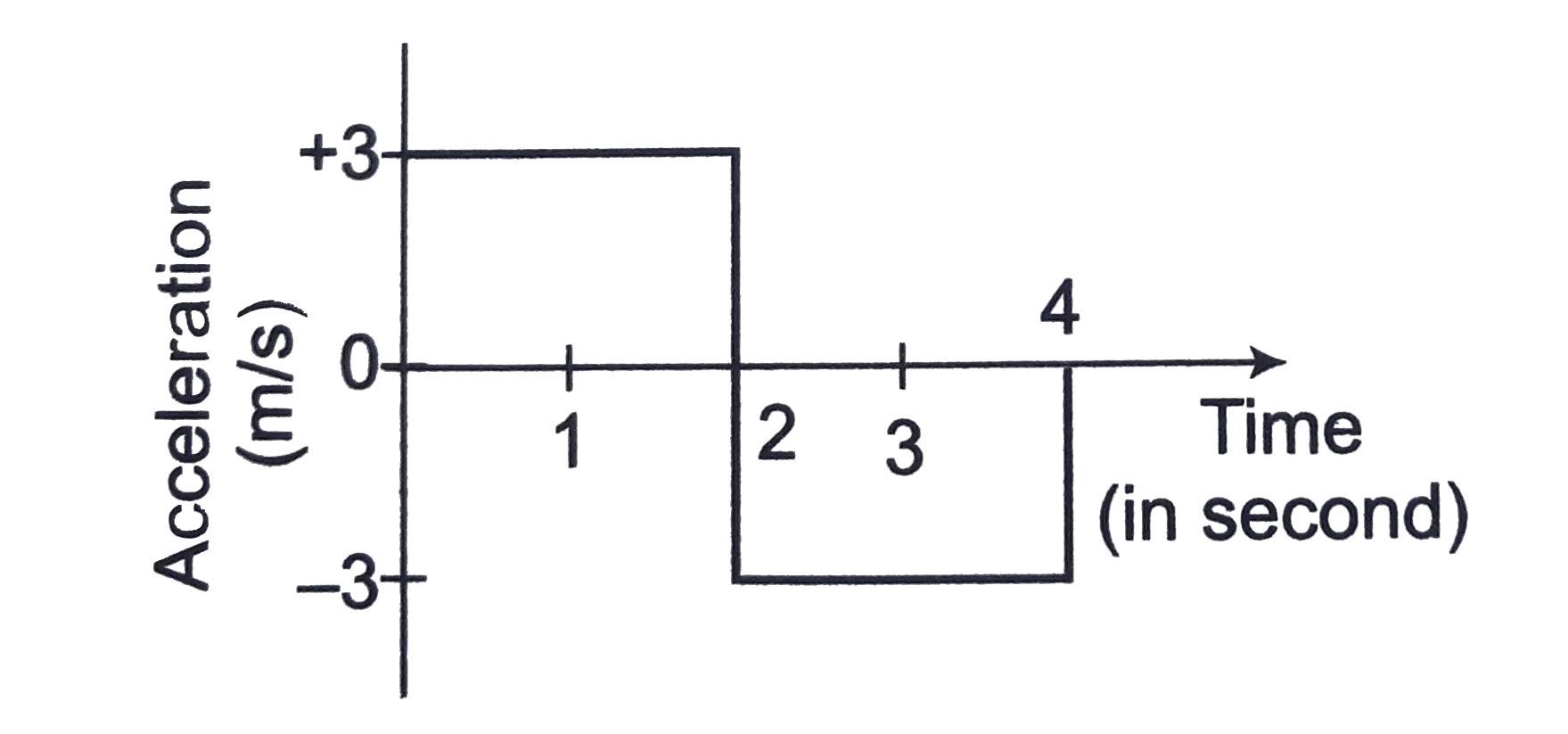A particle starts moving in a straight from rest with constant acceleration until it reaches velocity v. The distance travelled by it until this point is x . Then, it covers a further distance x at constant velocity. Finally, it slows down to rest at a constant rate such that it covers distance 2x. The total time for which the particle moved is T .Then ,Tvx=
To solve the problem step by step, we will analyze the motion of the particle in three distinct phases: acceleration, constant velocity, and deceleration.
Step 1: Analyze the first phase (Acceleration)
The particle starts from rest and accelerates to a velocity v over a distance x.
Using the first equation of motion:
v=u+at
where u=0 (initial velocity), we have:
v=at1(1)
Using the second equation of motion for distance:
s=ut+12at2
Substituting u=0:
x=12at21(2)
Step 2: Analyze the second phase (Constant Velocity)
In this phase, the particle moves with constant velocity v for a distance x.
The time taken for this phase is:
t2=xv(3)
Step 3: Analyze the third phase (Deceleration)
In the final phase, the particle decelerates to rest while covering a distance of 2x.
Let the retardation be a1. Using the first equation of motion:
0=v−a1t3⇒t3=va1(4)
Using the second equation of motion for distance:
2x=vt3−12a1t23
Substituting v=at1 from equation (1):
2x=(at1)t3−12a1t23(5)
Step 4: Relate the accelerations
From the first phase, we have:
a=vt1
From the third phase, we can express a1 in terms of a:
a1=a2(since it decelerates at half the acceleration)
Step 5: Substitute a1 in the equation
Substituting a1=a2 into equation (5):
2x=(at1)t3−12(a2)t23
Now, substituting t3=va1=2va:
2x=(at1)(2va)−14a(2va)2
This simplifies to:
2x=2vt1−14⋅4v2a
Thus:
2x=2vt1−v2a
Step 6: Total time T
The total time T is the sum of the times for all three phases:
T=t1+t2+t3
Substituting the values from equations (1), (3), and (4):
T=t1+xv+2va
Step 7: Calculate Tvx
Now, we need to find Tvx:
Tvx=vx(t1+xv+2va)
Substituting t1=x12at21 and simplifying gives us:
Tvx=7
Final Answer
Thus, the final result is:
Tvx=7
The particle starts from rest and accelerates to a velocity v over a distance x.
v=u+at
where u=0 (initial velocity), we have:
v=at1(1)
s=ut+12at2
Substituting u=0:
x=12at21(2)
In this phase, the particle moves with constant velocity v for a distance x.
t2=xv(3)
In the final phase, the particle decelerates to rest while covering a distance of 2x.
0=v−a1t3⇒t3=va1(4)
2x=vt3−12a1t23
Substituting v=at1 from equation (1):
2x=(at1)t3−12a1t23(5)
From the first phase, we have:
a=vt1
From the third phase, we can express a1 in terms of a:
a1=a2(since it decelerates at half the acceleration)
Substituting a1=a2 into equation (5):
2x=(at1)t3−12(a2)t23
Now, substituting t3=va1=2va:
2x=(at1)(2va)−14a(2va)2
This simplifies to:
2x=2vt1−14⋅4v2a
Thus:
2x=2vt1−v2a
The total time T is the sum of the times for all three phases:
T=t1+t2+t3
Substituting the values from equations (1), (3), and (4):
T=t1+xv+2va
Now, we need to find Tvx:
Tvx=vx(t1+xv+2va)
Substituting t1=x12at21 and simplifying gives us:
Tvx=7
Thus, the final result is:
Tvx=7
Topper's Solved these Questions
- BOOK - VMC MODULES ENGLISHCHAPTER - KINEMATICS OF A PARTICLE EXERCISE - JEE MAIN (archive)19videos
KINEMATICS OF A PARTICLE
- BOOK - VMC MODULES ENGLISHCHAPTER - KINEMATICS OF A PARTICLE EXERCISE - JEE Advanced (archive)14videos
KINEMATICS OF A PARTICLE
- BOOK - VMC MODULES ENGLISHCHAPTER - KINEMATICS OF A PARTICLE EXERCISE - LEVEL 175videos
KINEMATICS OF A PARTICLE
- BOOK - VMC MODULES ENGLISHCHAPTER - JEE MAIN REVISON TEST-23EXERCISE - PHYSICS (SECTION 2)1videos
JEE MAIN REVISON TEST-23
- BOOK - VMC MODULES ENGLISHCHAPTER - LAWS OF MOTION EXERCISE - IMPECCABLE53videos
LAWS OF MOTION
Similar Questions
A particle, initially at rest, starts moving in a straight line with an acceleration a=6t+4m/s2. The distance covered by it in 3 s is
View SolutionA particle starts from rest with constant acceleration. The ratio of space-average velocity to the time average velocity is :-
View SolutionA particle starts from rest and moves with constant acceleration. Then velocity displacement curve is:
View SolutionA particle starting from rest moves along a straight line with constant acceleration for this velocity displacement graph will have the form-
View SolutionA body ,starting from rest and moving with constant acceleration,covers 10m in the first second.Find the distance travelled by it in the next second.
View SolutionA particle starts moving from position of rest under a constant acceleration. If it travels a distance x in t second, what distance will it travel in next t second?
View SolutionA particle starts from rest at t=0 and moves in a straight line with an acceleration as shown below. The velocity of the particle at t=3 s is
 View Solution
View SolutionA particle at rest starts moving in a horizontal straight line with a uniform acceleration. The ratio of the distances covered during the fourth and third seconds is
View SolutionA particle starts moving from rest with uniform acceleration. It travels a distance x in the first 2 sec and a distance y in the next 2 sec. Then
View SolutionA body moving in a straight line with constant acceleration covers distances a and b in successive equal time interval of t. The acceleration of the body is
View Solution

